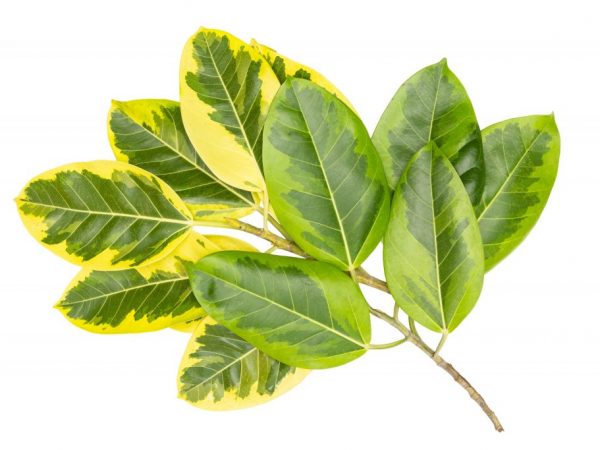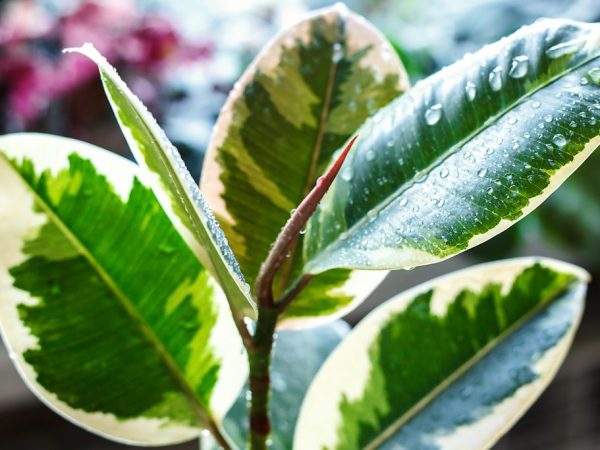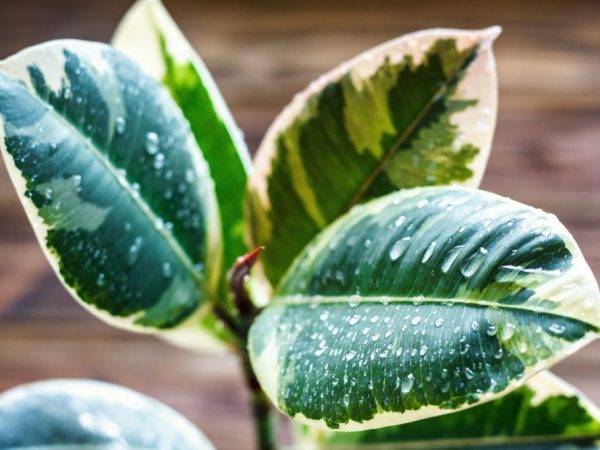How to care for ficus Elastica
Ficus Elastica is a lush green tree that is prized for its crown, not flowers. Today, many subspecies of the plant have been discovered and studied, including the ficus Elastica, or the ficus Elastica mix. It is a special species with a gigantic size. Under natural conditions, Elastica grows in the hot tropics, can reach a record height of about 30-40 m in height. This type of ficus is used not only as a landscape decoration, but also to make rubber.

Taking care of elastica ficus
Despite its gigantic size, Elastica ficus is used to decorate the house. Preference is given to the varieties Tricolor, Abidjan, Dosheri, Variegata, Tineke, ficus Elastica Belize and so on.
What you need to know about leaving
The rubber-bearing ficus Elastica is considered an unpretentious plant, so it can be cultivated even by those who do not have much experience in floriculture. Despite this, some of the features are still worth knowing. This is necessary in order to prevent the appearance of yellowness on the leaves and the death of the roots. To start a conversation about caring for a ficus Elastic at home, you should describe the lighting conditions.
Lighting requirements
The first thing a novice grower needs to know about is that all rubbery ficuses love light, including the Belize subspecies, Abidjan Elastica ficus and Mix, which are most often used at home. Direct exposure to sunlight is not encouraged, preference should be given to diffused lighting. It is worth considering in advance where the palm tree will be located, because it does not tolerate rearrangements.
To provide adequate lighting in winter, you need to consider an artificial light source.
Temperature conditions
Ficus Elastica grows naturally in the tropics, so it is logical that the plant will require heat at home. The most acceptable indicators are considered to be the interval between 23 ° C and 27 ° C in summer, and about 21 ° C in winter.
Ficus Elastica does not react well to drafts and sudden changes in temperature. It is not recommended to keep the pot on a cold windowsill so as not to overcool the roots, and you should also avoid places near the doors. It is not forbidden to take out a pot with a tree to an open balcony if it is at least 19 ° C outside.
Watering
How often should a palm tree be watered? It needs water, but it categorically does not tolerate overflow. It is recommended to independently check how moist the earth is. If, when palpating the soil at the level of two phalanges, the earth has dried up, the tree should be watered.
Watering a large tree should be done a little less often, ideally when the earth has dried out by 5-6 cm.
For watering ficus Elastic, you cannot use cold water: the roots suffer from this.The best option is settled water, its temperature should be equal to room temperature.
Humidity
The need for water concerns not only watering, but also humidifying the air. The leaves should be sprayed several times a week, and if they are dusty, rinse with running water. The Elastica variety loves spraying more than others. It is advisable that a device for humidifying the air be installed near the pot with plants; it is recommended to maintain the barometer readings at around 45-60% humidity.
Do I need to feed
The bush needs fertilization, especially acutely - during the period of active growth, from spring to the end of summer. In the fall, feeding is stopped: it only harms the flower. You can either buy store products or do feeding yourself. In order to do it yourself, you need charcoal and nettle tincture. However, this takes time and desire, which is why most growers buy the fertilizer from the store.
The Bona trademark is considered the most effective remedy; it is suitable for both ficuses and palms. The drug is added to the soil 1 time in 10 days, at least 1 time in 2 weeks. In this case, top dressing should not fall on the foliage, so as not to cause yellowing of the leaves and their further fall. It is recommended to alternate organic and mineral fertilizing.
How does reproduction take place

The plant needs special soil.
How is ficus Elastica propagated at home? To do this, you can use traditional methods used in crop production, for example:
- seeds;
- by cuttings.
Regardless of the method chosen for the plant, you need to choose the right soil. For this purpose, only land purchased in a specialized store is suitable. The soil bag should say “For Ficuses and Palms”.
It is quite possible to prepare the soil for a palm plant yourself. This will require deciduous land, greenhouse and regular sand. In this case, the proportions must be observed - 2: 2: 1. Manure can be used as fertilizer, and expanded clay can be placed on the bottom of the container with ficus. Drainage formation helps to provide airflow to the root system.
Propagation using seeds
Ficus seeds are purchased at any flower shop, in which case detailed instructions will be attached to each package, telling how to plant correctly. Briefly describing all the actions, they will look like this:
- The seeds are kept in a special growth-stimulating solution for 24 hours.
- Already prepared seeds are planted in a special pot. For ficus, Elastica is not recommended very deep, but at the same time a wide container, the depth of replanting should be 0.5 cm.
- After planting, the soil is watered abundantly.
- The seed pot is covered with foil to create the effect of a greenhouse environment.
It will take about 2 months for the roots and first shoots to appear. To make the process go faster, you can use special growth stimulants, for example, the Epin trademark: it is ideal for rubbery ficus.
Cutting method
The described plant is most often propagated by cuttings. The best time for reproduction of the Elastic ficus is spring: thus, by the fall, sufficiently strong roots will develop. To get the same stalk, you need to properly prune the branches of the plant. You only need the very tip of the branch. Usually trimming is done with a length of about 12-15 cm. The cutting line must be oblique.
For grafting, you should not choose bare branches, ideally if there are several live succulent leaves on the material used.
After pruning, the cutting is placed in warm water at a temperature of about 25 ° C. For grafting, choose only opaque dishes, otherwise there is a high probability of the appearance of algae.
With this method, the roots should be expected in about a month, although this period can also be significantly reduced by adding special chemicals to the water for growth.
How to transplant
How to transplant ficus Elastic? It is recommended to give it time to root in the pot. It will take about a year, only after this period the root system will branch out so much that the roots will no longer fit in the pot. Usually, early spring or early autumn is chosen for the transplant procedure, when the plant is at rest.
Before transplanting, the plant is first watered abundantly with water to soften the soil, and only after that they begin to pull it out of the pot. First, you need to remove the top layer of the soil, after which - to carry out the direct extraction of the tree and further transplantation. At the new site, you need to worry about sufficient drainage, while the planting depth should remain the same as before.

Ficus needs to be transplanted every two years.
If we are talking about a planned transplant of a rubber-bearing ficus, the Elastic ficus should be transplanted no more than once every 2 calendar years. Sometimes you can limit yourself to just replacing the topsoil to rejuvenate the plant.
Growing problems
Ficus Elastica does not always look attractive, for many reasons its appearance may become unusable. Drying can be caused by parasite damage or flower disease. Let's start with a description of the diseases inherent in the flower.
Ficus diseases
Diseases most often affecting ficus Elastic:
- Anthracnose. Caused by a fungal infection. In this case, the leaves of the ficus get dark yellow spots over the entire area, after which they fall off. Subsequently, this can lead to the complete death of the tree. To help the plant, you need to immediately start using fungicides, as well as establish the correct watering system.
- Circosporosis. This ficus disease also occurs due to fungal infection, only by others. A sign of the disease is the presence of many black markings on the leaves. Treatment for circosporosis is exactly the same as for anthracnose;
- Ficus dropsy. With this disease, a characteristic fungal growth occurs on the opposite side of the foliage, which is a consequence of excessive watering of the soil. To cure the plant, you need to carefully remove the damaged leaf, and then set up the watering system.
- Decay of the root system. This disease can be called the most dangerous for the flower, since rotting is caused by mold, which will be too difficult to get rid of. In this case, the plant withers very quickly, the leaves fall off, the roots die. To prevent this from happening, you urgently need to transplant the ficus, while it is important to remove all roots affected by mold.
Parasites
Ficus is also susceptible to parasites, let's find out about the most common:
- Spider mite. It parasitizes on succulent leaves of ficus and drinks their juice. Ficus can be cured with the help of mechanical removal of small spiders and cobwebs, as well as the use of special preparations. Usually Aktelik is used to treat ficus Elastic. This is a liquid that must first be dissolved in water.
- Shield. This pest infects many domestic plants, including the Elastica ficus. Outwardly, the parasite looks like small brown bugs that make the leaves sticky to the touch. The most effective way to get rid of the martyrs is mechanical cleaning and wiping the leaves with soapy water.
- A mealybug can damage green foliage, it can really be noticed right away, since its colonies usually hang from still healthy green leaves. As in the previous method, parasites must be removed mechanically, after which the leaves are lubricated with a weak alcohol solution.
- Thrips. This parasite lives only on the outside of the foliage. If you carefully examine a leaf of a rubber-bearing ficus, you can see how black moving dots and white hatched eggs with larvae are located on the leaf.An excellent way to get rid of the problem is to treat it with insecticides. Usually 2-3 times are enough. At the same time, it is important to remove the diseased plant from healthy ones in order to prevent further spread of the disease.
Errors in the care of ficus
Problems with the Elastica ficus can arise not only due to parasites or diseases, but also if the flower has been improperly taken care of at home. Before starting treatment with various means, you need to understand the real reason for the poor appearance of the Elastic ficus. The most common flower problems:
- The leaves of the ficus are drooping. Maybe the plant is trying to communicate in this way that it does not have enough moisture. If you notice the cause in time and increase watering, soon the leaves will turn green and juicy again.
- Ficus leaves turn yellow. This signals that there is too much moisture - the frequency of watering should be reduced.
- The ficus has stopped growing, the leaves are no longer as bright green as before. To remedy the situation, you need to feed the flower, this is the only way to fix the problem.
- The leaves have acquired a brown color, the trunk itself has turned yellow: there is a possibility that the plant has frozen. To return the ficus to its normal state, you need to insulate the tub, and then choose a warmer place to keep the ficus.
- Ficus threw off all the leaves, its elastic trunk became bare. This is caused by a change in the location of the flower or its significant hypothermia. If fertilizers are applied to the soil in time and an irrigation system is established, the situation will soon stabilize.
Signs associated with ficus
There are many beliefs and signs associated with the ficus Elastic. Moreover, opinions about the meaning of a flower differ depending on how to interpret a dream or a sign. For example, many believe that keeping a ficus in a house or apartment negatively affects men and sows constant quarrels in the family. However, the overwhelming majority of superstitious people believe that the ficus can only be a sign of good and positive signs.
It is not for nothing that the plant is often used in the professional decoration of houses and apartments, for example, in the Feng Shui system. In order for it to bring happiness to household members, it is not enough just to buy a tub with a plant, you need to choose a special place where the flower can open all its energy centers.
Ficus often appears in the home through donation. So, for example, a flower plant can be presented to newlyweds for a wedding. There is a sign that if there is this tree in the house, the bride will become pregnant faster. Even after the birth of a baby, the ficus will not stop its positive mission. It is recommended to place it near the baby's cradle so that the baby sleeps peacefully and sweetly.
In dream books you can find interpretation of dreams in which ficus is found. Usually ficus Elastica at home dreams of money, getting unexpected wealth. It is not worth saying that money bills will be surrounded immediately after awakening, but some increase in material terms will still occur in the near future.


